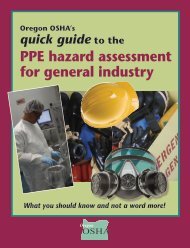Technical Manual - Section 3 (Safety Hazards)
Technical Manual - Section 3 (Safety Hazards)
Technical Manual - Section 3 (Safety Hazards)
Create successful ePaper yourself
Turn your PDF publications into a flip-book with our unique Google optimized e-Paper software.
<strong>Safety</strong><br />
Depending on the product and service, backflow prevention<br />
from the discharge line may be needed. The failure of<br />
automatic pump controls could cause a deviation in process<br />
pressure and temperature. Pumps operated with reduced or no<br />
flow can overheat and rupture. Pressure relief in the discharge<br />
piping should be provided where pumps can be<br />
overpressured. Provisions may be made for pipeline<br />
expansion, movement, and temperature changes to avoid<br />
rupture. Valves and instruments that require servicing or<br />
other work should be accessible at grade level or from an<br />
operating platform. Operating vent and drain connections<br />
should be provided with double-block valves, a block valve<br />
and plug, or blind flange for protection against releases.<br />
Health<br />
Safe work practices and/or appropriate personal pro-tective<br />
equipment may be needed for exposure to haz-ards such as<br />
those related to liquids and vapors when opening or draining<br />
pumps, valves, and/or lines, and during product sampling,<br />
inspection, and maintenance activities.<br />
TANK STORAGE<br />
Atmospheric storage tanks and pressure storage tanks are<br />
used throughout the refinery for storage of crudes,<br />
intermediate<br />
hydrocarbons (during the process), and finished products.<br />
Tanks are also provided for fire water, process and treatment<br />
water, acids, additives, and other chemicals. The type,<br />
construction, capacity and location of tanks depends on their<br />
use and materials stored.<br />
HEALTH AND SAFETY CONSIDERATIONS<br />
Fire Prevention and Protection<br />
The potential for fire exists should hydrocarbon storage tanks<br />
be overfilled or develop leaks that allow vapors to escape and<br />
reach sources of ignition. Remote sensors,control valves,<br />
isolation valves, and fire valves may be provided at tanks for<br />
pump-out or closure in the event of a fire in the tank, or in the<br />
tank dike or storage area.<br />
<strong>Safety</strong><br />
Tanks may be provided with automatic overflow control and<br />
alarm systems, or manual gauging and checking procedures<br />
may be established to control overfills.<br />
Health<br />
Safe work practices and/or appropriate personal protective<br />
equipment may be needed for exposure to hazards related to<br />
product sampling, manual gauging, inspection, and<br />
maintenance activities including confined-space entry where<br />
applicable.<br />
III:2-57
















